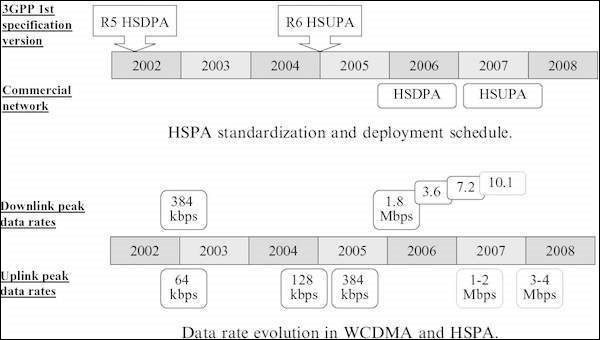
- UMTS Tutorial
- UMTS - Home
- History of Mobile Communication
- Cellular Concepts
- Cellular Concepts - Introduction
- GSM Architecture
- Cellular Concepts - GSM Radio Link
- Cellular Concepts - Mobility
- Cellular Concepts - GPRS
- Cellular Concepts - EDGE
- UMTS Introduction
- UMTS - A New Network
- UMTS - WCDMA Technology
- UMTS - HSPA Standardization
- UMTS - Objectives
- UMTS - Authentication
- UMTS - Success and Limitations
- UMTS Networks Standardization
- UMTS - 3GPP
- UMTS - Radio Access Network
- UMTS - Evolved Packet Core
- UMTS Protocol Environment
- UMTS - GPRS Tunneling Protocol
- UMTS - Proxy Mobile IPv6
- UMTS - EAP
- UMTS - IKEv2 & MOBIKE
- UMTS - SCTP
- UMTS - NAS Signaling Protocol
- UMTS Useful Resources
- UMTS - Quick Guide
- UMTS - Useful Resources
- UMTS - Discussion
UMTS - HSPA Standardization
Let's look at the standardization and deployment schedule of HSPA in brief −
High-speed downlink packet access (HSDPA) was standardized as part of 3GPP Release 5 with the first specification version in March 2002.
High-speed uplink packet access (HSUPA) was part of 3GPP Release 6 with the first specification version in December 2004.
HSDPA and HSUPA together are called High-Speed Packet Access’ (HSPA).
The first commercial HSDPA networks were available at the end of 2005 and the commercial HSUPA networks were available on 2007.
The HSDPA peak data rate available in the terminals is initially 1.8Mbps and will increase to 3.6 and 7.2 Mbps during 2006 and 2007, and later on 10Mbps and beyond 10Mbps.
The HSUPA peak data rate in the initial phase was 1–2 Mbps and the second phase was 3–4Mbps.

HSPA is deployed over the WCDMA network on the same carrier or - for high capacity and high speed solution - using another carrier, see figure above. In both cases, WCDMA and HSPA can share all the network elements in the core network and the radio network comprising base stations, radio network controller (RNC), Serving GPRS Support Node (SGSN) and the Gateway GPRS Support Node (GGSN). WCDMA and HSPA also share the site base station antennas and antenna cables.
The upgrade WCDMA HSPA requires new software and potentially new equipment in the base station and RNC to support the rate and higher data capacity. Because of the shared infrastructure between WCDMA and HSPA, the cost of the upgrade WCDMA HSPA is very low compared to the construction of a new stand-alone data network.